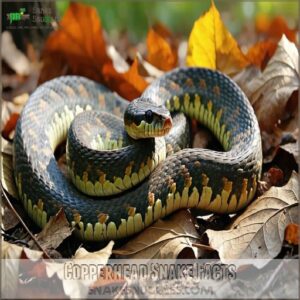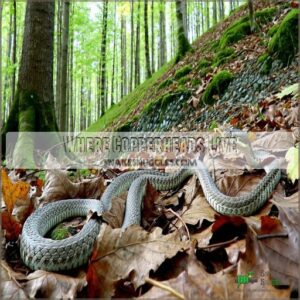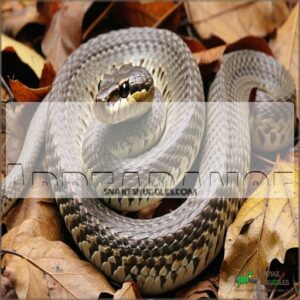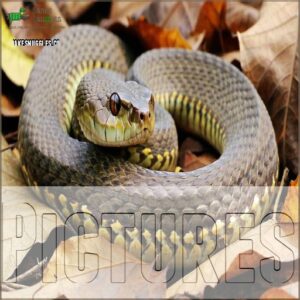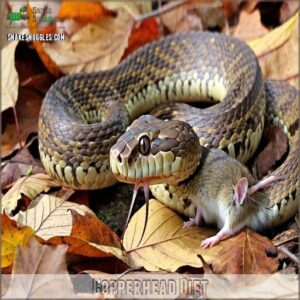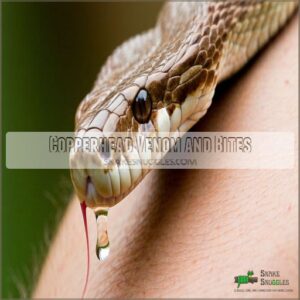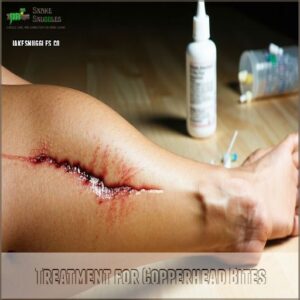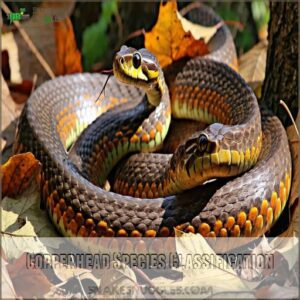This site is supported by our readers. We may earn a commission, at no cost to you, if you purchase through links.
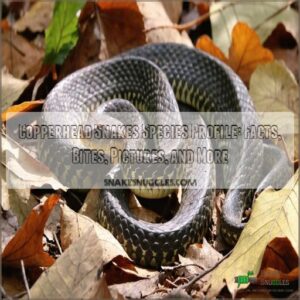
These masters of camouflage rock a tan-to-brown body with hourglass markings.
They’re ambush predators, patiently waiting for a tasty mouse or lizard dinner.
Found across the eastern US, they thrive in forests and rocky areas.
Their hemotoxic venom, while rarely fatal if treated, can pack a punch.
Bites are more common than you’d think, but fatalities are rare – they’re not out to get you, honestly.
Curious about how to tell them apart from harmless look-alikes?
There’s more to uncover about these copperhead snakes.
Table Of Contents
- Key Takeaways
- Copperhead Snake Facts
- Where Copperheads Live
- Identifying Copperheads
- Copperhead Behavior
- Copperhead Diet
- Copperhead Venom and Bites
- Treatment for Copperhead Bites
- Copperhead Species Classification
- Copperheads Vs Other Snakes
- Copperhead Conservation Status
- Frequently Asked Questions (FAQs)
- What are some interesting facts about copperheads?
- What does a copperhead bite look like?
- What smell do copperheads hate?
- How long do you have once bitten by a copperhead?
- What time of day are copperheads most active?
- How long do copperheads live?
- Do copperheads lay eggs or give live birth?
- What predators commonly eat copperheads?
- How do I differentiate a copperhead from other venomous snakes?
- What are the common predators of copperheads?
- Conclusion
Key Takeaways
- You’ll find copperheads in the eastern and central US, blending into their surroundings with their coppery head and hourglass-shaped markings. They’re ambush predators, patiently waiting for prey.
- Copperhead bites deliver hemotoxic venom, targeting blood cells and tissues. While rarely fatal if treated, bites require immediate medical attention. First aid includes washing the bite, removing tight clothing near the wound, and keeping the area still and elevated.
- Copperheads are ovoviviparous, meaning they give birth to live young. They play a crucial role in controlling rodent populations.
- You can distinguish copperheads from other venomous snakes by their hourglass markings. Rattlesnakes have rattles, and cottonmouths have a more blocky head and lack the hourglass pattern. Give them space, and they’ll likely avoid you.
Copperhead Snake Facts
Copperhead snakes are fascinating yet misunderstood pit vipers found across the eastern and central U.S., thriving in diverse snake habitats. Averaging 2-3 feet long, these stout-bodied reptiles sport tan and coppery hues with hourglass-shaped crossbands—perfect camouflage for forest floors.
Their triangular heads house heat-sensing pits, making them stealthy hunters. Copperhead behavior is unique—they’re ambush predators, waiting patiently among leaves to pounce on small mammals.
For more information on copperhead snake encounters, to fully understand their habitat and behavior is necessary. Despite venom effects being rarely fatal, a copperhead bite requires immediate attention.
Contrary to copperhead myths, they don’t chase people but may vibrate their tails or strike if provoked. Understanding copperhead species helps you handle wild encounters safely and keep nature’s balance intact.
Where Copperheads Live
You’ll find copperheads quietly thriving across much of the eastern and central United States, from southern New England to Texas.
They hide out in forests, rocky hillsides, and even suburban areas, blending perfectly into leaf litter with their camouflage—nature’s version of a stealth mode.
Geographic Range
In their native habitats, copperhead snakes cover a lot of territory across the southeastern United States and beyond. Their geographic range stretches from southern New England all the way down to Florida and westward to Nebraska, Kansas, and Texas. These flexible reptiles embrace all kinds of terrain features, from rocky hillsides to wetlands, thriving in diverse climate zones. For more information on copperhead snake characteristics, they steer clear of higher Appalachian elevations, preferring foothills and lowlands.
- They steer clear of higher Appalachian elevations, preferring foothills and lowlands.
- Border areas, like suburban edges, see plenty of sightings due to habitat overlap.
- Regional distribution highlights their knack for blending into leaf litter in forests or near water bodies.
Copperheads truly know how to adapt!
Habitat
Looking for copperhead snakes? These masters of camouflage thrive in diverse environments. They’re right at home in forest ecosystems and wetland habitats, blending seamlessly into leaf litter.
To understand their behavior, knowing copperhead habitats and how they utilize them for survival is key.
- Rocky outcrops and low mountains
- Hardwood and pine forests
- Water sources like streams and swamps
- Overgrown farmlands and woodpiles
- Suburban areas near natural landscapes
Their versatility explains sightings, even in western NY!
Identifying Copperheads
You can spot a copperhead by its signature hourglass-shaped markings, coppery head, and tan or brown body that blends perfectly into leaves.
Keep an eye out for their triangular head and, if it’s a young one, a bright yellow-green tail tip—it’s nature’s way of giving them a flashy “baby on board” sign!
Appearance
Spotting a copperhead snake isn’t always easy—they blend right into their surroundings. Their tan to light brown body color, marked with dark hourglass-shaped bands, helps them vanish into leaf litter like nature’s magic trick.
Chunky, triangular heads set them apart from other snakes, crowned with a coppery hue and fine dark speckles. Copperhead characteristics also include heat-sensing facial pits and vertical pupils, perfect for hunting anytime. Young copperheads rock bright yellow tail tips for attracting prey.
For accurate snake identification, it’s key to examine these distinct features closely. Their camouflage ability makes copperhead identification tricky, so tread carefully when outdoors!
Pictures
Photographing copperheads is like spotting art in nature—those tan bodies with chestnut hourglass bands blend right into dead leaves.
To make your visual ID easier, here’s what to watch for:
- Hourglass patterns on a tan or light brown body.
- Triangular coppery heads.
- Elliptical pupils, like a cat’s.
- Juvenile tails, tipped bright yellow, perfect bait for prey.
Copperhead Behavior
You might think copperheads are just lazy, but their ambush hunting shows they’re masters of patience and stealth.
They’re also surprisingly tricky in the area of reproduction, with females giving birth to live young after carrying them internally for months, which showcases their stealth.
Hunting
Ever wonder how a copperhead hunts? These pit vipers are masters of ambush tactics, perfectly camouflaged as they lie in wait.
Imagine a copperhead, still as a stone, blending seamlessly into the leaf litter—a true master of disguise. Its heat-sensing facial pits act like infrared goggles, detecting unsuspecting prey. A quick strike, and the prey is subdued with venom.
| Prey Capture | Hunting Strategies |
|---|---|
| Mice | Ambush |
| Rats | Sit-and-wait |
| Lizards | Snake Stalking |
| Frogs | Wild Tracking |
Reproduction
After a successful hunt, a copperhead’s focus shifts to reproduction. Mating season kicks off between February and May. Unlike many snakes that lay eggs, copperheads give live birth!
This fascinating process involves:
- Internal egg development: The eggs incubate inside the mother.
- A gestation period of roughly three months.
- Birth cycles typically occurring from July to October, producing 4-8 live young.
This strategy boosts the survival odds of the newborns. Want to see copperhead giving live birth images? Search "copperhead live young" or "do copperheads give live birth".
Copperhead Diet
Beyond simply lying in wait, a copperhead’s diet involves a strategic hunt for various prey. What do copperheads eat? Think mice, voles, and chipmunks—the usual suspects in Alabama and beyond. But their menu also includes the occasional unlucky bird, amphibian, or even smaller snake.
The copperhead’s ability to catch copperhead prey is a key factor in its survival. Visualize this: a young copperhead, all 7 inches of it, wiggling its bright yellow tail like a worm to lure a curious frog. An adult, though, prefers the element of surprise, blending into the leaf litter like an 8 out of 10 camouflage expert, waiting for a 6-inch mouse to wander too close.
And while the end of a cicada’s summer might be at 6:08 PM, a copperhead’s dinner bell could ring anytime, from 10:07 AM to 10:20 PM, depending on the copperhead snake activity. The most recent discussions online suggest a copperhead may eat only 10 to 12 meals a year, a demonstration of their patience and the 5-star quality of their ambush tactics.
Copperhead Venom and Bites
So, you’ve learned what fuels these coppery critters. Now, let’s talk venom. A copperhead snake bite delivers hemotoxic venom, a cocktail that targets your blood cells and tissues. Don’t panic, it’s rarely a death sentence with proper care.
- Copperhead venom disrupts blood clotting.
- Bites cause localized pain, swelling, and tingling—ouch!
- Antivenom treatment is available for severe cases.
Copperhead bites are the most common venomous snake bites in the US, but fatalities are rare. These venomous snakes aren’t aggressive; they only strike when threatened. Think of their venom as a tool for hunting small prey, not for snake attacks on humans. Their toxic compounds are designed for mice, not people. If a copperhead bites you, seek immediate copperhead bite treatment for humans. Venom effects and bite symptoms vary, but prompt action guarantees a better outcome. Remember, understanding venomous snakes and their behavior is key to peaceful coexistence.
Treatment for Copperhead Bites
So, you’ve learned about the nasty venom a copperhead packs. Now, what happens if you’re bitten? Copperhead bite treatment for humans focuses on minimizing venom effects and promoting recovery.
First aid is key: wash the bite with soap and water, remove tight clothing or jewelry near the wound, and keep the area still and below heart level. Don’t try to suck out the venom or use a tourniquet!
Effective copperhead bite management requires prompt medical attention. Medical response involves monitoring your vitals and managing bite symptoms like swelling, pain, and potential tissue damage. For serious cases, antivenom neutralizes the venom’s impact. Copperhead snake bite injury facts show bites are rarely fatal, but prompt copperhead bite treatment is essential.
- Stay calm—panic restricts blood flow.
- Elevate the bite—gravity helps.
- Seek medical attention—professionals know best.
- Show copperhead bite swelling pics to the doctor—visuals aid diagnosis.
Copperhead Species Classification
After understanding copperhead bite treatment, let’s explore their family tree. The copperhead snake, Agkistrodon contortrix, stands alone in its genus, yet nestled within the Viperidae family, specifically the Crotalinae subfamily – home to pit vipers.
Think of it like this: Viperidae is the whole neighborhood, Crotalinae is a specific street, and Agkistrodon is a unique house on that street.
While just one species, copperheads across southeastern North America show subtle variations, like different paint jobs on the same car model. Genetic research reveals these subspecies classifications and local adaptations, influencing everything from their diet to their behavior. This species profile highlights the importance of Taxonomy Systems and understanding the Evolution History of the Copperhead Snake, ensuring these fascinating pit vipers thrive.
Copperheads Vs Other Snakes
Let’s compare copperheads to other venomous snakes like cottonmouths or rattlesnakes. Copperhead venom, while hemotoxic, is milder than many other pit vipers. It disrupts blood cells but is rarely fatal if treated. Their bite, however, can be a real pain – literally!
| Feature | Copperhead | Rattlesnake | Cottonmouth |
|---|---|---|---|
| Venom | Hemotoxic, mild | Hemotoxic, potent | Hemotoxic, potent |
| Habitat | Forests, rocky areas | Deserts, grasslands | Swamps, wetlands |
| Behavior | Ambush predator, camouflaged | Active hunter, warning rattle | Aggressive, displays threat posture |
Copperheads stick to North America, unlike cobras and vipers with their worldwide fame. They’re masters of disguise, blending into leaves to ambush small prey. While a copperhead bite is serious, these snakes mainly strike when threatened. Knowing these species differences helps us appreciate their role and avoid negative snake interactions.
Copperhead Conservation Status
Protecting copperhead snakes means focusing on habitat preservation, a key aspect of wildlife conservation. Currently, widespread copperhead species protection isn’t in place federally.
They’re not listed as endangered, except in Massachusetts, highlighting the regional differences in copperhead conservation. Ironically, humans are the biggest threat, mainly through habitat loss and roadkill, impacting ecosystem balance.
While locally abundant, their future hinges on species preservation through biodiversity management, especially at the edges of their range. Think of it like this: copperheads thrive in a balanced ecosystem; disrupting their habitat is like pulling a Jenga block—you never know when the whole tower will tumble.
So, protecting their spaces safeguards the whole environment, which relies on biodiversity management and ecosystem balance, ensuring that wildlife conservation efforts are successful.
Frequently Asked Questions (FAQs)
What are some interesting facts about copperheads?
Copperheads can live several years in the wild, giving birth to live young.
Their venom may even hold secrets to fighting cancer, and they’re nature’s pest control, keeping rodent numbers down.
What does a copperhead bite look like?
A copperhead bite typically causes pain, swelling, redness, and bruising around two small puncture wounds. You might also see blisters or discoloration.
What smell do copperheads hate?
Strong smells like cinnamon, cloves, or essential oils might deter copperheads. Try sprinkling these around areas you’d like to keep snake-free.
How long do you have once bitten by a copperhead?
Seek immediate medical attention. Copperhead venom, while rarely fatal, requires prompt treatment to minimize potential tissue damage and other complications.
What time of day are copperheads most active?
Like a vampire, they shy away from the sun. Copperheads are most active at night during hot months and during the day when it’s cooler.
How long do copperheads live?
In the wild, you can expect copperheads to live for a good 18 years, sometimes even stretching it to 20, which is quite a while for these slithery critters.
Do copperheads lay eggs or give live birth?
Copperheads don’t lay eggs. They give birth to live young, called ovoviviparity, where eggs hatch inside the mother.
What predators commonly eat copperheads?
Larger snakes, hawks, owls, foxes, coyotes, and bobcats consider copperheads a menu item. Even kings have enemies, and copperheads are no exception in the wild.
How do I differentiate a copperhead from other venomous snakes?
Check for hourglass markings. Copperheads have them; cottonmouths and rattlesnakes don’t. Rattlesnakes, of course, have rattles. Water moccasins have a more blocky head and lack the hourglass pattern.
What are the common predators of copperheads?
Imagine a copperhead‘s world, where danger lurks above and below. Predators include hawks, owls, kingsnakes, coyotes, and even large bullfrogs. Stay safe!
Conclusion
Alright, Sherlock, we’ve cracked the case of the copperhead snakes species profile with bite information facts and pictures!
These cryptic critters, with their hourglass markings and hemotoxic venom, deserve our respect.
Remember, they’d rather avoid you than bite, so give them space.
Understanding their behavior, habitat, and appearance helps us coexist.
Stay safe, appreciate these fascinating reptiles, and share your newfound copperhead wisdom!
- https://www.bluecrossnc.com/blog/healthy-living/health-conditions/copperhead-snake-bite-care
- https://www.reptileknowledge.com/squamata/copperhead.php
- https://www.poison.org/articles/copperhead-snakes
- https://www.livescience.com/43641-copperhead-snake.html
- https://www.istockphoto.com/photos/copperhead-snake

